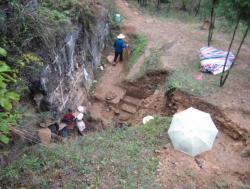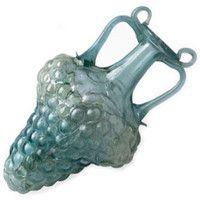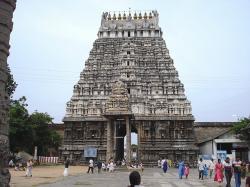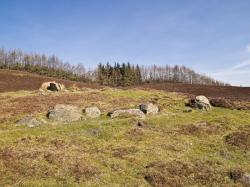INSTITUT SUPERIEUR D'ANTHROPOLOGIE
INSTITUTE OF ANTHROPOLOGY
ONLINE COURSES / COURS A DISTANCE
INSCRIPTION 2012 / Session III : Juillet 2012
REGISTRATION 2012 / Term III : July 2012
CHINE –  Longuppo - Une étude franco-chinoise confirme l’antiquité de la présence humaine en Chine. La datation de plusieurs gisements chinois majeurs a été entreprise en utilisant la combinaison des méthodes de la résonance de spin électronique et de l’uranium thorium (ESR/U-Th), grâce au soutien du programme EGIDE PHC Cai Yuanpei et de l’Ambassade de France en Chine. Une partie de cette étude, portant sur le site de Longuppo (Chongqing), a été récemment publiée dans la revue Quaternary Geochronology : les résultats préliminaires obtenus sur ce gisement confirment l’antiquité d’une présence humaine en Chine, il y a plus d’un million et demi d’années.
Longuppo - Une étude franco-chinoise confirme l’antiquité de la présence humaine en Chine. La datation de plusieurs gisements chinois majeurs a été entreprise en utilisant la combinaison des méthodes de la résonance de spin électronique et de l’uranium thorium (ESR/U-Th), grâce au soutien du programme EGIDE PHC Cai Yuanpei et de l’Ambassade de France en Chine. Une partie de cette étude, portant sur le site de Longuppo (Chongqing), a été récemment publiée dans la revue Quaternary Geochronology : les résultats préliminaires obtenus sur ce gisement confirment l’antiquité d’une présence humaine en Chine, il y a plus d’un million et demi d’années.
http://www.mnhn.fr/museum/foffice/national/national/presse/communiques/commPresse/fichePresse.xsp?ANNEE=2012&COMMPRESSE_ID=7263&idx=59&nav=liste
FRANCE –  - L'Inrap et le Centre Culturel et Touristique du Vin ont signé une convention de partenariat visant à diffuser des contenus culturels sur l'archéologie du vin. Premier fruit de cette collaboration : le programme interactif « L'archéologie du vin ». Ce programme présente, à travers les apports de l'archéologie, une frise interactive sur l'histoire de la vigne et du vin. Depuis la Préhistoire jusqu'aux Temps Modernes, de grands thèmes sont évoqués et abondamment illustrés : techniques et production, culture et société, mythes et religions, pratiques funéraires, sciences, échanges et commerce. Des liens contextuels renvoient vers des sites archéologiques récemment fouillés en France. Enfin, une rubrique permet de faire le point sur la généalogie de la vigne, ses modes de culture et la culture du vin. Largement illustré de documents d'archives, de photos et de vidéos, « L'archéologie du vin » combine des approches chronologique et cartographique, l'interactivité permettant de naviguer aisément d'un axe à l'autre.
- L'Inrap et le Centre Culturel et Touristique du Vin ont signé une convention de partenariat visant à diffuser des contenus culturels sur l'archéologie du vin. Premier fruit de cette collaboration : le programme interactif « L'archéologie du vin ». Ce programme présente, à travers les apports de l'archéologie, une frise interactive sur l'histoire de la vigne et du vin. Depuis la Préhistoire jusqu'aux Temps Modernes, de grands thèmes sont évoqués et abondamment illustrés : techniques et production, culture et société, mythes et religions, pratiques funéraires, sciences, échanges et commerce. Des liens contextuels renvoient vers des sites archéologiques récemment fouillés en France. Enfin, une rubrique permet de faire le point sur la généalogie de la vigne, ses modes de culture et la culture du vin. Largement illustré de documents d'archives, de photos et de vidéos, « L'archéologie du vin » combine des approches chronologique et cartographique, l'interactivité permettant de naviguer aisément d'un axe à l'autre.
http://archeologie-vin.inrap.fr
INDE –  Kancheepuram - Renovated 1,100-year-old Varadharaja Perumal temple in Kancheepuram consecrated. Said to be the second oldest temple in Kancheepuram after the Ekambaranathar temple which has more than a thousand ancient temples, the Varadharaja Perumal temple was built by the famous Chola king Raja Raja I in 1053AD (a year before king Raja Raja died). Later, the temple on 23 acres was expanded by subsequent Chola kings, including Kulottunga chola I and Vikrama chola. Anticipating a Muslim invasion in 1688 AD, the local chieftain sent the main image of the deity to Udayarpalayam, now part of Trichy. It was brought back with great difficulty after the involvement of a local preceptor who enlisted the services of general Todarmal of Vijayanagara era. The temple showcases the architecture of ancient Vishwakarma Sthapathis with three outer precincts namely Azhwar Prakaram, Madai Palli Prakaram and Thiru Malai Prakaram, 32 shrines, 19 vimanams, 389 pillared halls (most having the lion yali sculpture) and sacred tanks. One of the most famous architectural pieces in the temple is the huge chain sculpted from a stone. There is a 100-pillared hall with sculptures depicting Ramayana and Mahabharata, a masterpiece of Vijayanagara architecture. "There are 362 inscriptions on the walls of the temple ranging from Cholas to Vijayanagara periods," said retired deputy superintendent of state archaeology department, K Sridharan.
Kancheepuram - Renovated 1,100-year-old Varadharaja Perumal temple in Kancheepuram consecrated. Said to be the second oldest temple in Kancheepuram after the Ekambaranathar temple which has more than a thousand ancient temples, the Varadharaja Perumal temple was built by the famous Chola king Raja Raja I in 1053AD (a year before king Raja Raja died). Later, the temple on 23 acres was expanded by subsequent Chola kings, including Kulottunga chola I and Vikrama chola. Anticipating a Muslim invasion in 1688 AD, the local chieftain sent the main image of the deity to Udayarpalayam, now part of Trichy. It was brought back with great difficulty after the involvement of a local preceptor who enlisted the services of general Todarmal of Vijayanagara era. The temple showcases the architecture of ancient Vishwakarma Sthapathis with three outer precincts namely Azhwar Prakaram, Madai Palli Prakaram and Thiru Malai Prakaram, 32 shrines, 19 vimanams, 389 pillared halls (most having the lion yali sculpture) and sacred tanks. One of the most famous architectural pieces in the temple is the huge chain sculpted from a stone. There is a 100-pillared hall with sculptures depicting Ramayana and Mahabharata, a masterpiece of Vijayanagara architecture. "There are 362 inscriptions on the walls of the temple ranging from Cholas to Vijayanagara periods," said retired deputy superintendent of state archaeology department, K Sridharan.
http://timesofindia.indiatimes.com/city/chennai/Renovated-1100-year-old-Varadharaja-Perumal-temple-in-Kancheepuram-consecrated/articleshow/14687014.cms
ROYAUME UNI –  Glenshee - The excavation at the site of a Pitcarmick-type building was part of a new research programme on the early medieval landscapes of the area. The Pitcarmick buildings first discovered at Strathardle were recognised in the 1990s as being rare examples of early medieval rural building. However, not much is currently known about them and the results from this latest excavation will greatly increase knowledge of this type of structure. “Pitcarmick-type buildings take their name from the area in which they were first discovered. They are turf-walled houses dating from around 800-900 AD and this is the only area in Scotland that we know of where there is surviving evidence of Pitcarmicks. The example here at the Lair is a really long building. The site that we are excavating is around 30 metres by 10. We think it was possibly a byre-dwelling with people living in the top half on the higher ground and their animals living in the lower half. “These types of buildings are really difficult to excavate since they were made of turf walls, with a turf roof and have no stone foundations so it isn’t always clear where the boundaries between the walls and the roof for example might have been.” There were also two Bronze Age roundhouses and a burial cairn at the site.
Glenshee - The excavation at the site of a Pitcarmick-type building was part of a new research programme on the early medieval landscapes of the area. The Pitcarmick buildings first discovered at Strathardle were recognised in the 1990s as being rare examples of early medieval rural building. However, not much is currently known about them and the results from this latest excavation will greatly increase knowledge of this type of structure. “Pitcarmick-type buildings take their name from the area in which they were first discovered. They are turf-walled houses dating from around 800-900 AD and this is the only area in Scotland that we know of where there is surviving evidence of Pitcarmicks. The example here at the Lair is a really long building. The site that we are excavating is around 30 metres by 10. We think it was possibly a byre-dwelling with people living in the top half on the higher ground and their animals living in the lower half. “These types of buildings are really difficult to excavate since they were made of turf walls, with a turf roof and have no stone foundations so it isn’t always clear where the boundaries between the walls and the roof for example might have been.” There were also two Bronze Age roundhouses and a burial cairn at the site.
http://icperthshire.icnetwork.co.uk/tm_headline=perthshire-archaeology-month-excavation-at-glenshee-comes-to-a-close%26method=full%26objectid=31313323%26siteid=113960-name_page.html
TOBAGO – Scarborough - The Tobago House of Assembly (THA) recently granted permission to a team of archaeologists to lead the scientific investigation of a cultural heritage project in the Scarborough Harbour. Led by Dr Kroum N Batchvarov, assistant professor of maritime archaeology at the University of Connecticut and Affiliated Scholar of the Institute of Nautical Archaeology, the team will exhume the wrecks of the Dutch ships sunk in these waters during the 1677 battle between a French squadron and the Dutch West Indies Company. The excavation of the remnants of one of the largest battles fought outside of Europe in the 1600s is expected to provide a wealth of information, not only on the technology, economy and environment of the time, but also on the history of Caribbean settlement.
http://www.stabroeknews.com/2012/news/breaking-news/07/05/shipwrecks-project-to-boost-tobago-tourism/
SLOVAQUIE – Košice - Some 1,000 archaeological objects have been found and identified during two years of excavations along a stretch of the R4 dual carriageway currently under construction between Košice and Milhošť. Most of the objects found date back to prehistory. The largest discovery so far is a 45-metre-long clay pit that was probably used for extracting clay and manufacturing ceramics. Other finds unearthed during the excavation work include a unique grave containing a corpse lying in a foetal position in Seňa (Košice Region) that probably dates back to the Bronze Age. Archeológia Zemplín, the company in charge of the excavation work, has gradually explored six different locations with settlements dating from the Early Stone Age through to the Middle Ages.
http://spectator.sme.sk/articles/view/46888/10/some_1000_archaeological_objects_found_during_r4_construction.html
TURQUIE –  Çatalhöyük - UNESCO has decided to add Turkey's Çatalhöyük, a Neolithic settlement in southern Anatolia, to UNESCO's World Heritage List. The site is an important example of the transition period in which villages were gradually transformed into urban centers. It contains 18 levels of Neolithic occupation, showing various cultural practices dating back to the Chalcolithic period, according to UNESCO's website. With the addition of Çatalhöyük the number of sites in Turkey included on the UNESCO World Heritage List has increased to 11.In addition to being an archeological site, Çatalhöyük is a major tourist attraction, featuring several wall paintings, sculptures and ornaments such as bracelets and necklaces, all of which can be seen by visitors. Testifying to a period of rich culture, the site also includes several Neolithic-era houses all standing very close to each other with roofs that serve as both windows and doors; the inhabitants seem to have entered their homes through the roof.
Çatalhöyük - UNESCO has decided to add Turkey's Çatalhöyük, a Neolithic settlement in southern Anatolia, to UNESCO's World Heritage List. The site is an important example of the transition period in which villages were gradually transformed into urban centers. It contains 18 levels of Neolithic occupation, showing various cultural practices dating back to the Chalcolithic period, according to UNESCO's website. With the addition of Çatalhöyük the number of sites in Turkey included on the UNESCO World Heritage List has increased to 11.In addition to being an archeological site, Çatalhöyük is a major tourist attraction, featuring several wall paintings, sculptures and ornaments such as bracelets and necklaces, all of which can be seen by visitors. Testifying to a period of rich culture, the site also includes several Neolithic-era houses all standing very close to each other with roofs that serve as both windows and doors; the inhabitants seem to have entered their homes through the roof.
http://www.todayszaman.com/news-285239-unesco-inscribes-catalhoyuk-on-world-heritage-list.html